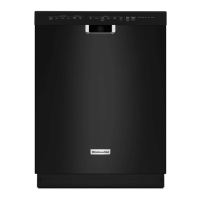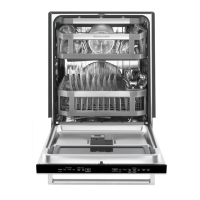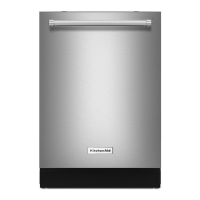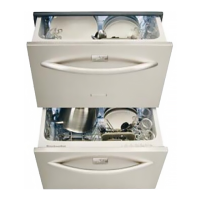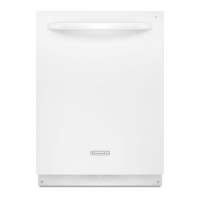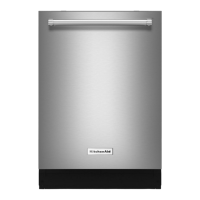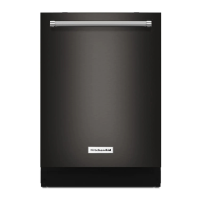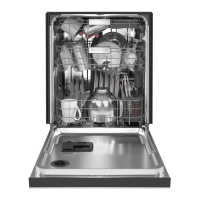
Do you have a question about the KitchenAid KDSS-20 and is the answer not in the manual?
| Type | Built-In |
|---|---|
| Number of Racks | 2 |
| Energy Star Certified | Yes |
| Third Rack | No |
| Stainless Steel Tub | Yes |
| Soil Sensor | Yes |
| Color | Stainless steel |
| Cutlery Basket | Yes |
| Delay Start | Yes |
| Depth | 24 inches |
| Place Settings | 14 |
Details the comprehensive one-year warranty for the entire dishwasher.
Covers the one-half horsepower motor for five years against defects.
Provides a five-year warranty for the solid state control components.
Offers a ten-year warranty against water leaks from the tank/inner door.
Outlines the procedure for obtaining service or repair.
Specifies exclusions from warranty coverage, such as misuse or accidents.
Emphasizes the importance of reviewing all instructions prior to operating the dishwasher.
Stresses the need for correct grounding and using the dishwasher only for its designed purpose.
Advises on using recommended detergents and keeping them away from children.
Guides on loading sharp items safely and avoiding damage to seals.
Instructs on washing plastic items only if marked "dishwasher safe."
Warns against touching the heating element during or immediately after operation.
Prohibits operating the unit without panels and tampering with controls.
Discourages abuse and warns against children playing on or in the dishwasher.
Alerts users to the risk of explosive hydrogen gas and provides a safety procedure.
Provides instructions for removing the door when discarding the dishwasher.
States the dishwasher operates on 115 volts AC and cannot be converted.
Advises insulating water lines to prevent freezing and ruptures.
Requires removing door hinges/latch mechanism when discarding.
Introduces the advanced electronic features of the dishwasher.
Outlines the simple sequence of choosing cycles and starting the dishwasher.
Explains how the dishwasher heats water to 150°F, allowing lower home water heater settings.
Provides a step-by-step guide to initiating a dishwasher cycle.
Details the available wash cycles (Soak & Scrub, Heavy Wash, Low Energy).
Explains the Soak & Scrub cycle for heavily soiled items.
Describes the Heavy Wash cycle for moderately soiled loads.
Outlines the Low Energy Wash cycle for normal to light soil loads.
Explains the Rinse & Hold cycle for rinsing partial loads until a full load is ready.
Describes the Sani Rinse option for sanitizing dishes with hot water.
Details the Energy Saver option to eliminate heat during the dry cycle.
Instructs to touch the START pad to begin the selected wash and dry program.
Explains the Cycle Monitor and Cycle Time indicators during operation.
Lists common sounds to expect while the dishwasher is running.
Explains how to modify wash or rinse/dry selections within 30 seconds of starting.
Details the process to cancel an ongoing cycle using the CANCEL pad.
Explains how to delay the cycle start for up to nine hours using the DELAY WASH pad.
Instructs how to cancel a delay and start the cycle immediately.
Explains how display messages in the CYCLE TIME window indicate status.
Describes the 'dO' display for when the dishwasher door is left open.
Explains the 'PF' display indicating a power interruption and reset procedure.
Details the 'CA' display shown when the CANCEL pad is pressed.
Shows how the number of hours for a delayed cycle is displayed.
Advises against hand rinsing and using liquid detergent for pre-wash.
Explains how to adjust the 16-position upper rack for optimal loading.
Guides on placing platters, trays, and pans in the high position of the lower rack.
Advises on loading pitchers, deep bowls, and tall stemware in the low position of the upper rack.
Guides on securing plastics and glassware in the outer row of dividers.
Illustrates proper placement of cups and mugs for effective water drainage.
Describes overlapping or "butterfly" loading for small plates.
Guides on loading plates, pots, pans, and cookware in the lower rack.
Suggests various ways to load cereal and soup bowls based on shape.
Advises on removing the basket and loading silverware for best washing results.
Recommends loading sharp utensils with handles up to prevent injury.
Instructs to load forks and spoons so they do not nest together for proper cleaning.
Lists materials and provides special information on their dishwasher safety.
Notes potential finish effects on anodized aluminum from heat and detergent.
Warns that cast iron seasoning will be removed, causing rust.
Advises checking manufacturer recommendations, noting potential fading of patterns.
Recommends checking manufacturer recommendations for leaded crystal.
Notes discoloration for gold flatware, glass yellowing, and adhesive issues for knives.
Provides guidance on washing pewter, plastics, and stainless steel items.
Advises on washing sterling silver, notes tin may rust, and warns about wooden ware.
Lists acceptable automatic dishwasher detergents and warns against soaps.
Advises adding detergent just before starting and storing it properly.
Explains single, double, and triple fill levels based on soil and cycle.
Guides on determining detergent amounts based on water hardness levels.
Discusses using more detergent with low-phosphate options in hard water.
Explains how rinse agents reduce water spots and improve drying.
Details how to locate and fill the rinse agent dispenser.
Identifies key components of the dishwasher through a numbered diagram.
Provides advice on cleaning the interior, control panel, and exterior surfaces.
Explains how to clean the drain air gap for proper drainage.
Warns against operating the dishwasher without racks in place.
Step-by-step instructions for removing the upper dishwasher rack.
Instructions on how to remove the lower dishwasher rack from the unit.
Describes the two-part system that traps food soils and larger items.
Step-by-step guide for removing and cleaning the fine filter.
Instructions for removing and cleaning the coarse strainer.
Provides various tips for saving energy during operation and idle periods.
Explains the "flash dry" process to quickly evaporate water from dishes.
Details steps for protecting the dishwasher from freezing in seasonal dwellings.
Outlines simple steps for safeguarding the dishwasher during summer closure.
Addresses issues of food soil remaining on dishes and their solutions.
Explains causes and solutions for spotting and filming on dishware.
Discusses low water temperature as a cause for poor performance and solutions.
Identifies a blocked spray nozzle on the wash arm as a cause for cleaning issues.
Addresses issues causing the cycle to take an unusually long time.
Explains reasons why dishes may not be drying properly.
Details causes and limitations for removing silica film or etching from glassware.
Explains aluminum markings and how to prevent or remove them.
Discusses brown stains caused by high iron content and their treatment.
Addresses issues with white spots on non-stick cookware after washing.
Provides solutions for eliminating odors within the dishwasher.
Discusses improper loading as a cause of dishware chipping and solutions.
Explains causes for frequent fine filter cleaning and checks.
Addresses the issue of food soil remaining on dishes before loading.
Lists basic checks to perform before calling for service.
Directs users to the problem chart for washing issues.
Guides users to warranty statements for service contact information.
Provides information on contacting MACAP for unresolved issues.
Lists essential details to include when writing about dishwasher service.
Reiteration of basic checks for operational failures before calling service.
Reminder to consult the problem chart for washing issues.
Guides users to check warranty statements for service contact information.
Explains when and how to contact the Major Appliance Consumer Action Panel.
Lists essential details to include when writing about dishwasher service.
Introduces the option to change front panels for a new look.
Warns to disconnect power before changing panels to prevent shock.
Step-by-step guide for removing and replacing the upper front panel.
Step-by-step guide for removing and replacing the lower front panel.
Information on ordering and installing custom wood front panels.
Details how to order custom panels in different solid colors.
Describes the features and benefits of the KitchenAid trash compactor.
Highlights the performance and durability of KitchenAid stainless steel disposers.
Explains the convenience and uses of the Instant-Hot water dispenser.
Details the capabilities and unique mixing action of KitchenAid solid state mixers.
Describes the power and versatility of KitchenAid multi-function food processors.



